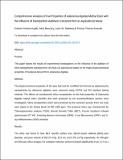| dc.description.abstract | Purpose
This paper reports the results of experimental investigations on the influence of the addition of silica nanoparticles extracted from rice husk (an agricultural waste) on the major physicochemical properties of biodiesel derived from Adansonia digitata.
Methods
The physicochemical properties of the base fuel and the modified fuel formed by dispersing the nanoparticles by ultrasonic agitation were measured using ASTM and EN standard testing methods. The effects of manufactured silica nanoparticles on the fuel properties of Adansonia digitata methyl esters (ADME) that were produced by the transesterification process were investigated. Silica nanoparticles which were produced by the extraction process from rice husk were doped at the dosing levels of 400–1000 ppm. The produced silica was characterized by Thermogravimetry analysis (TGA), Barrett Emmett Teller (BET), Fourier transform infrared spectroscopy (FT-IR), Scanning electron microscope (SEM), X-ray fluorescence (XRF), and X-ray diffractometer (XRD) methods.
Results
The silica was found to have BET specific surface area, Barret-Joyner Halenda (BJH) pore diameter, and pore volume of 502.24 m2/g, 19.3 nm, and 0.761 cm3/g respectively. At 400 ppm and 800 ppm silica dosages, the oxidation induction period increased significantly from 5.2 h to a high of 10.3 h. These findings showed that ADME's oxidation stability had improved significantly to satisfy the ASTM D6751 and EN 14,214 standard limits of > 3 h and > 8 h, respectively. The kinematic viscosity of ADME dropped as the additive content increased, from 4.62 mm2/s for pure biodiesel to 2.21 mm2/s for 400 ppm. Furthermore, it was discovered that the largest increase in viscosity occurs at high doses of 600–1000 ppm. The flash point increased linearly as the amount of nanoparticle addition was increased. Higher flash point temperatures are desirable for improving engine performance and for safety issues. Also, results showed that cetane number (CN) increases from 60 to 64 simultaneously at the dosing level between 400 and 800 ppm and dropped to 63 at dosing levels beyond 800 ppm. The blending of Silica/Alumina showed the best improvement of CN of ADME about 33.6%. Commercial additive (Al2O3) showed an improvement of oxidation stability up to a dosing level of 800 ppm. Fuel blending of (B100 + SiO2), (B20 + SiO2), and (B20 + Al2O3) was also performed and the results showed that the oxidation induction period (OIP) increases from 3.8 to 10.3 h for (B100 + SiO2) blending up to dosing level of 800 ppm but decreases at 1000 ppm. However, blending (B20 + SiO2) showed significant improvement on OIP from 47.2% to 64.16% at 0 to 1000 ppm respectively but blending of B20 and Al2O3 showed the best improvement about 71.7% at 1000 ppm but slightly decreased at 600 ppm (15.7 h). Kinematic viscosity showed slight improvement (decrease by 32.6%) at 400 ppm, but increases at 600 ppm (4.16 mm2/s) for B20 + SiO2 fuel blending. However, at higher dosing level decreases by 3.85% up to 1000 ppm. Dosing of Al2O3 additive on B20 fuel blend displayed the improvement decreasing by 36.9% at 600 ppm but at higher dosage (1000 ppm) increases to 5.2 mm2/s for Al2O3.
Conclusion
Generally, from this study it has been observed that rice husk nano-particle is considered as a potential fuel-borne catalyst than the commercial one to improve the fuel properties, owing to their enhanced surface area to volume ratio probably due to its 3-dimensional tetrahedral coordination and covalent nature of silicon atom | en_US |

